
This week, starting Thursday, a fifth of the world’s population will celebrate Chinese New year. Guò nián—gwo niyan—is Mandarin for New Year, and Guò nián just might be the most widely celebrated occasion in the entire world.
|
Chinese New Year is celebrated throughout China according to ancient traditions. Mao’s Cultural Revolution destroyed millions of buildings, statues, paintings, and treasures from China’s deep past, but cultural expressions are much more difficult to change. Many traditions involve food.
And for food, people go home. Government offices, factories, schools and universities shut down for three to five weeks so that people can visit their families. In Hong Kong, it’s called Golden Week. All over China, trains and buses are crammed with people, airplanes seats are sold out, stations and airports have massive line-ups and crowds as everyone goes home for the holidays. See video for this mass homeward journey at http://www.youtube.com/watch?v=wLW72HXbZ_k&feature=channel
Just as we have Christmas and Thanksgiving and Hallowe’en traditions that don’t exactly make a lot of sense (A fat man coming down a chimney? Ghosts bobbing for apples? Consuming a large flightless bird?) the Chinese have traditions that Euro-Canadians may call “superstitions.”
Chinese language and speech are rich with allusions, and metaphor and sound create play in both daily speech and in creation of meaning. Foods have symbolic meanings based on their appearance, colour, and the sound of the spoken word. Hence bean curd or tofu is considered unlucky at this time of the year because it is white, the colour of death, and four of anything is shunned because “su” means both four and death. Noodles are served uncut, as their length represents long life. Fish and chicken are served whole, as these represent completeness. Lotus seeds represent fertility, gingko nuts mean silver, black moss seaweed is a homonym for wealth, roots and fibrous vegetables are favoured, as are bamboo shoots and dried bean curd. All over China, jiaozi — (pronounced djow’zih) or what we call pot stickers, are a favourite food. The dumplings are lucky because they are shaped the way gold and silver ingots used to be, in ancient China.
Chinese Food in Revelstoke
Revelstoke has had Chinese food since the very early days. The Oyster and Chophouse on MacKenzie Avenue where the Avalanche Centre is now located, was open in the early 1900s. In the remote railway and mining camps, the Chinese were often the only men who knew how to cook, so they did, and Canadians have eaten Chinese food for over a century. Who can forget high school days, when movie night always ended up with take-out egg rolls? They’re almost a national dish.
Three Chinese restaurants are still thriving in Revy, but the menus have expanded considerably since the days of chow mein and chop suey as the main fare. All the restaurants emphasize freshness, just as we found to be the case in China when we spent eight months there in 2008-09. The veggies are tender-crisp (after all, it was wok cooking that taught us how to cook veg), the shrimp done just exactly to the point of being cooked but still crunchy, the chicken tender and juicy. All three restaurants are run by Chinese families: Zoë Situ and Paul Wu at the Hong Kong Restaurant; Felix Huang and his family at WK Garden, and Eric and Jackie Ma, the new owners of Mannings.
All our Chinese restaurants offer Canadian-Chinese dishes. Eric Ma, the new owner of Mannings, says this is mainly because real Chinese food often has so much fat that Canadians wouldn’t like it. It’s true, at least sometimes. When we were in China (for 8 months in 08-09) we often ate a lot of fat. One of my students took us to the fanciest restaurant in Yan Jiao — it was gorgeously decorated in a tropical style, and so enormous the waiters wore roller blades to get around. We ate a delicious meal that included pork fat — just that, skin on —I n a ginger garlic sauce — supposedly excellent for the skin. It tasted great, but the texture is one that Canadians just aren’t used to.
WK Garden Chinese Restaurant
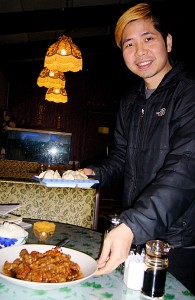
Felix Huang and his family are from Guangzhou, and came to Canada a few years ago after his father retired from a government job. Felix and his wife now have a 3-year-old named Eric. They have run the restaurant since 2005. Felix says dumplings — jiaozi — or pot stickers, are the most common food in China at New Year’s, so we ordered some to have with his other specialty, ginger beef.
The ginger beef was great — very crispy beef strips in a pungent garlic-ginger sauce with carrot shreds — extremely filling. And the jiaozi were delicious. Felix’s wife makes them.
Every world cuisine has some form of a pot sticker — parcels of meat and veggies inside a little case of pastry. At WK Garden, these are light and delectable, boiled not fried, with a light sauce of soy sauce, vinegar and a bit of chili oil. Felix sent me the recipe, see below.
Hong Kong Restaurant
Paul Wu and his wife Zoë Situ emigrated to Canada in 2002; Zoë worked at Mannings before she and Paul took over the Hong Kong. Their son Victor is 8 and goes to Columbia Park.

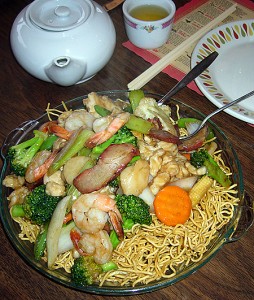
We ate a wonderful Vegetable Chow Mein—big enough for two—full of stir fried tender-crisp veggies in big pieces and large cooked-just-right prawns on top of crispy noodles.
Zoe cooked a special plate of sesame chicken for me — recipe below — and I went back on Sunday to pick it up. We ate it at home with the jiaozi I made from Eric’s recipe, and some spring rolls I made with the left-over chicken filling with added bok choy.
Mannings Restaurant
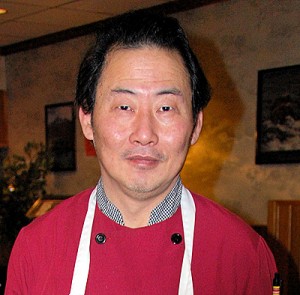
Mannings Friday night buffet is almost a tradition in Revelstoke, and is now also open Saturday. Eric and his wife Jackie took over at Mannings last summer. Jackie is from Shanghai; Eric came from Hong Kong to go to high school in Calgary, where he later worked in the restaurant industry. He can make you an authentically Chinese New Year dinner, but needs advance notice in order buy the right things.

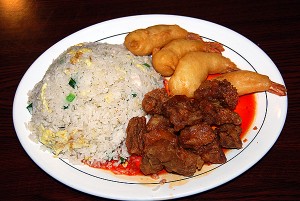
We sampled the combination lunch, which can be any three items from the combo plates on the menu. Between two of us, this meant six different dishes: Chicken Fried Rice, Sweet Sour Boneless Pork, Deep Fried Prawns, Chicken Chow Mein, Crushed Almond Chicken and Beef Chop Suey. It was a generous and delicious lunch. David loved the chop suey, which Eric does with big pieces of fresh veggies — broccoli and cauliflower — and beef, over bean sprouts.
Jiaozi – Pot Sticker Dumplings from WK Garden
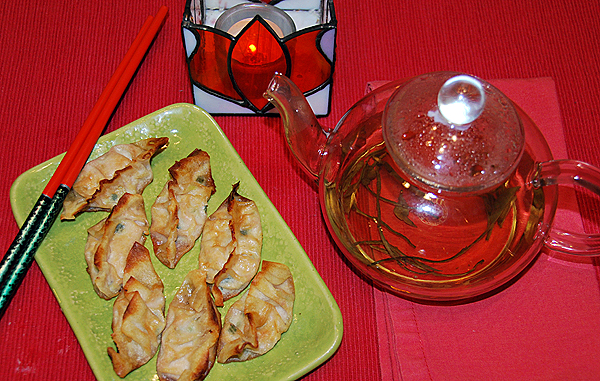
When we lived in China and shopped at the huge Jinka Long supermarket, the frozen dumpling section took up an open horizontal freezer as long as the two meat freezers at Cooper’s — an amazing variety. We had seen a video on Chinese TV about making dumplings in vast factories and the scope of the operation admittedly put me off. So it’s great to know you can get these home-made at WK Garden, or make your own from scratch. They are easy to do, although fiddley and time-consuming. Felix says this is the number one food consumed all over China at New Year, and it certainly was true in Yan Jiao where we lived, where some shops sold nothing else, all year long.
Pot sticker wrappers are round and thin. They are also sold as Japanese gyoza wraps. I couldn’t find any in Revelstoke, so used the spring roll wrappers from the produce section of the grocery store, near the tofu. You can make the dough from scratch with flour and hot water, but most people buy the wrappers. You’ll have to cut out rounds. Use a glass and press hard, then use scissors. I cut 8 at once. However, without the wrappers for pot stickers, you can’t boil them as Felix does. I tried, and the wrapper does cook, but turns quite gluey. Bake them, or fry, unless you can obtain real pot sticker wraps. These are very good — small tasty bites, and Tanis, who spent three years in China, says, “They taste really Chinese.”
Makes about 60 small pot stickers
2 lb. ground chicken, turkey or pork
1 cup finely chopped green vegetable: spring onion, leeks, cabbage, celery or all
1 tbsp chicken stock
1 ½ tsp sesame oil
1 ½ tsp white wine vinegar
1 ½ tsp sugar
1 tsp salt
1 tbsp corn starch
2 eggs
For sealing paste: mix 1 tbsp flour with 2 of cold water.
Dice the vegetables with a cleaver until very finely chopped. Add these to the ground meat, along with the oil, chicken stock, vinegar, sugar and salt. Mix well. Beat the eggs and into them beat the cornstarch, mixing with the back of a spoon to make sure no lumps remain in the cornstarch. Mix eggs and cornstarch into the meat and stir very well. Add 1 tsp white pepper if you want a zingy flavour.
Cut out 3” circles of wrapper dough. Use a brush to coat the edges (about ¼ inch) with sealing paste. Put a teaspoonful of meat in the centre and fold over. Press down hard along the edges with your fingers. Then turn the little dumpling on its bum, so to speak, so the sealed edge points up, and flute and pleat the edges so they stay sealed. This is a bit tricky. Oiling your hands a little helps. Once the edge is sealed, let the dumpling sit on a plate for at least 15 minutes before cooking, so the “paste” dries. It’s important to keep the filling in the envelope.
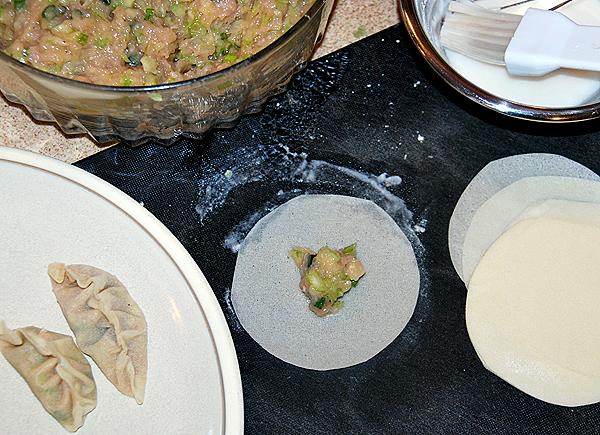
Fried pot stickers: Put 1 tsp oil in a frying pan. Heat until the oil looks curdled. Put 8-10 pot stickers in—each one should have room and shouldn’t crowd the others—and fry them gently until the bottoms are brown and crispy. Add ½ cup water. Cook until the water disappears. Continue cooking until the dumplings are dry again, adding another few drops of oil if they seem to stick.
Dipping sauce: mix 2 tsp light soya sauce with 1 tsp chili paste, 1 tsp honey and 1 tbsp vinegar.
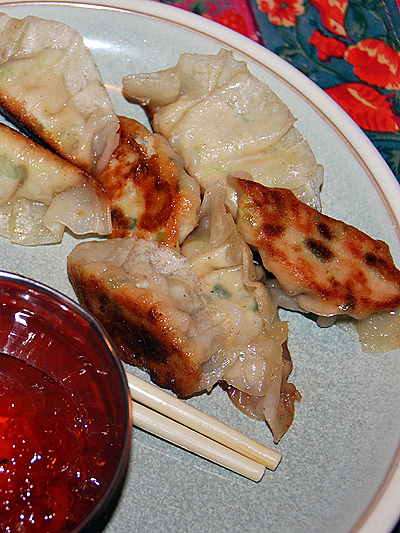
Baked pot stickers: Preheat oven to 425F. Mix up a little sauce of 1 tbsp oil, 1 tsp soya sauce and 1 tsp vinegar. Place a piece of parchment paper on a cookie sheet, and put the dumplings evenly lined up on the sheet. Brush the soya oil over the pot stickers with a pastry brush, very lightly. Bake for 10 minutes.
WARNING: Felix’s pot stickers are really addictive, they’re so good.
Zoë’s Sesame Chicken
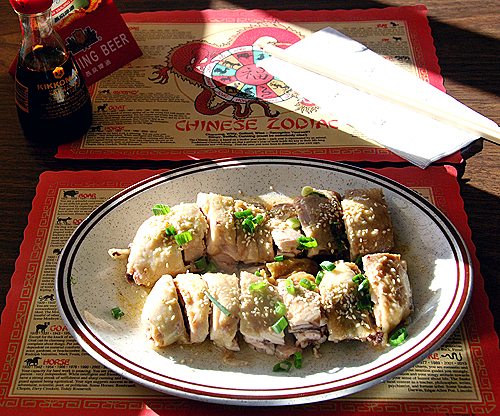
Serves 2
Chicken symbolizes family and unity for New Year’s. This is a very easy chicken recipe, and despite the simplicity has a really Chinese flavour, from the sesame oil and seeds. Zoë makes this with skin on and bone in, and uses the ¼ chicken pieces that give you both white and dark meat. Chinese cooking usually uses chicken on the bone, as it’s considered sweeter and more nutritious. If you don’t have a big cleaver with which to chop the cooked chicken, you could make it with boneless chicken. However, the skin needs to be on.
In China, every single part of the chicken is used, and the feet are a special delicacy. I’ve watched a family devour a whole plate of chicken heads. During the Cultural Revolution, when people now in their 40s and 50s were young, food shortages were severe and famine rampant, with possibly 20-30 million people dying of starvation. The result was that today, the Chinese in China waste nothing, and eat every part of every animal and food plant. In this dish, the skin and the fat underneath create flavour as well as the sauce. If you prefer skinless chicken, add a little peanut oil and ¼ cup of stock to the pan when you braise the chicken.
1 lb chicken with skin and bone
4 tsp sesame oil
2 tsp salt
water
2 tsp sesame seeds, toasted
2 tbsp green onion, chopped
Rub the chicken with the salt and the sesame oil and let it sit for one hour in the fridge.
In a medium sized saucepan with a tight-fitting lid, put the chicken in the pan and turn the heat to its very lowest setting. Cover tightly. Simmer for 30-40 minutes. The chicken will braise in its own juices. Check to make sure the chicken is done by slicing into it with a sharp thin knife. If the juices run clear, it’s done. Or check with an instant read thermometer for 180 F.
If you haven’t turned the heat really low and the chicken begins to burn, add a little water to the pan.
Toast sesame seeds in a frying pan over low heat, shaking continually for 2-3 minutes. The instant you can smell sesame, turn off the heat and leave them in the pan until ready to use.
When the chicken is done, remove from pan and slice diagonally into chunks, retaining shape of original piece. Sprinkle sesame seeds and chopped green onion overtop.
Gold and Red Fried Rice

Red and gold are New Year colours, and this fried rice uses both colours to make a lucky dish signaling prosperity and good fortune. Eric told us that “Anyone can do fried rice,” and I guess that’s so, but his was particularly light as well as flavourful with nice chunks of chicken in it. I tried to follow his example, and in this recipe cut in half the amount of oil called for.
Serves 6
1 tbsp peanut or canola oil
¼ cup chopped onion
1 tbsp grated fresh ginger
½ cup sliced mushrooms
¼ lb ground beef, pork, chicken or cooked ham diced (optional)
3 cups cold cooked long-grain rice
1 ½ cups grape or cherry tomatoes, each in half
1 tbsp soy sauce
2 tsp hoisin sauce
½ tsp salt
1 tbsp chicken broth or water
4 eggs
2 tbsp ketchup
¼ cup sliced green onions
Heat the oil in a large wok. Add the onions and ginger and stir fry for 2 minutes. Add the mushrooms and continue to cook until they begin to brown on the edges. Add the meat, if you are using it, and cook until meat is done. Leave the meat in bite size pieces, not crumbs. Add the rice and tomatoes, and the ketchup, and continue to stir, adding then the soy sauce, hoisin sauce, salt, and broth.
Beat the eggs in a separate bowl until well combined. In a separate pan, make a soft omelette with the eggs. Turn onto a chopping board and cut it into squares, then mix into the rice. Turn off the heat under the rice and add the green onions, sliced about the thickness of a looney, on the diagonal, and scatter about the top.
Throughout, stir fry very gently so that the tomatoes, meat if you use it, and egg, remain in distinct visible pieces. (The red and the gold!)
If you want more green, add ½ cup of frozen peas. For even more red and gold, though this is not traditional, add diced red, orange and yellow peppers.




